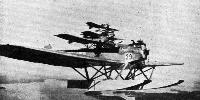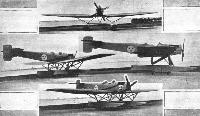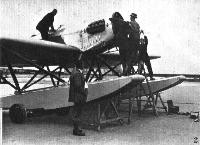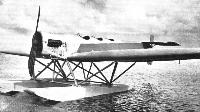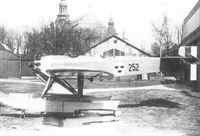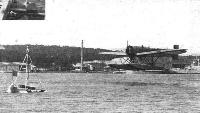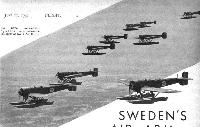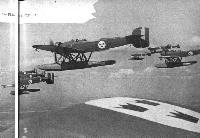
Heinkel: монопланы серии HE
Эрнст Хейнкель успешно трудился в должности главного конструктора компаний "Albatros", "Hansa und Brandenburg" и "Caspar", a 1 декабря 1922 года он основал в Варнемюнде собственную фирму "Ernst Heinkel Flugzeugwerke AG". Первым самолетом фирмы стал двухпоплавковый гидросамолет-низкоплан Heinkel HE 1, выполнивший первый полет в 1923 году. На этом моноплане (HE, Heinkel Eindecker) ставились разные моторы мощностью порядка 250 л. с. (186 кВт), например, такой как 240-сильный Siddeley Puma. Чтобы обойти международный запрет на оснащение германских самолетов моторами мощностью более 60 л. с. (45 кВт), HE 1 собирался в Швеции компанией "Svenska Aero AB" - в ВМС Швеции машины обозначались S1.
Улучшенный вариант с крылом большего размаха и мотором Rolls-Royce Eagle IX мощностью 360 л. с. (268 кВт) эксплуатировался в Швеции (вариант S2) и в Финляндии. 25 августа 1924 года на самолете компании "Heinkel" был установлен первый мировой рекорд - высота 5690 м достигнута с грузом массой 250 кг.
Схожий с HE 2, но оснащенный 360-сильным (268 кВт) мотором Rolls-Royce Eagle IX, самолет HE 4 выполнил первый полет в 1926 году, он стал переходным вариантом к новой машине HE 5 с мотором Napier Lion мощностью 450 л. с. (336 кВт). В июле 1926 года в Варнемюнде на этой машине установили мировой рекорд скорости набора высоты 4492 м с грузом массой 1000 кг.
<...>
В 1927 году появился самолет HE 8 с мотором Armstrong Siddeley Jaguar мощностью 450 л. с. (336 кВт); 22 таких самолета поставили ВМС Дании, 16 из них построила по лицензии компания "Orlogsvaerftet". Несколько машин продолжало летать в апреле 1940 года, последний экземпляр был собран в 1938 году. Самолет HE 31 - это модернизация HE 8 с мотором Packard мощностью 800 л. с. (597 кВт).
В 1928 году построили 2-/3-местный гидроплан HE 9 с мотором BMW VIa в 660 л. с. (492 кВт). 21 мая 1929 года на нем были установлены несколько мировых рекордов для гидросамолетов, в том числе рекорд скорости в 231 км/ч на 500-км маршруте с грузом 1000 кг. 10 июня на самолете HE 9 установили рекорд скорости на 1000-км маршруте с грузом 1000 кг.
Описание:
- Heinkel: монопланы серии HE
- Flight, March 1925
A SWEDISH RECONNAISSANCE TWIN-FLOAT SEAPLANE - Flight, July 1926
THE GERMAN SEAPLANE COMPETITION - Flight, June 1929
OLYMPIA AERO SHOW 1929
Фотографии
-
Мировая Авиация 154
Регистрационный номер: D-939 HE 1 сохранил компоновку монопланов Hansa-Brandenburg. Многие самолеты семейства HE использовались для обучения летчиков будущих Люфтваффе.
-
Air Enthusiast 1998-11 / L.Andersson - Heinkels for Sweden
The first version of the ‘Hansa’, the Caspar S.1, was produced in cooperation between Caspar-Werke in Germany, the Swedish Navy Dockyards and Svenska Aero. This aircraft (s/n 32) was the second built.
-
Air Enthusiast 1998-11 / L.Andersson - Heinkels for Sweden
‘Hansa’ 36 was assembled by the Naval Dockyards in 1923. Note the Lamblin radiators.
-
Flight 1924-11 / Flight
FORMATION FLYING IN SWEDEN: Our photograph shows one side of a formation of S.11 Svenska Aero A.B. seaplanes during practice. The photograph, which was taken from the Squadron-Leader's machine, shows typical Swedish "country" below.
-
Flight 1925-03 / Flight
Side view of the "S.II."
-
Flight 1925-03 / Flight
Nose of the "S.II," showing tubular mounting of the Rolls-Royce "Eagle" engine.
-
Air Enthusiast 1998-11 / L.Andersson - Heinkels for Sweden
No 42, the first Heinkel S.II, built by Svenska Aero in 1924.
-
Flight 1925-08 / Flight
A SWEDISH VISITOR: These four photographs show the Swedish seaplane with Rolls-Royce "Eagle" IX engine, on which Commander Flory flew from Stockholm to Felixstowe and back. On the return journey the flight from Felixstowe to Malmo was made, non-stop, in 7 hrs. 15 mins.
-
Air Enthusiast 1998-11 / L.Andersson - Heinkels for Sweden
Svenska Aero built a total of six Heinkel HE 4s for Latvia. No.20 was one of four delivered in 1927.
-
Авиация и Космонавтика 2018-04 / С.Дроздов - В небе Латвии (1918-2018)
Гидросамолеты Хейнкель He 4 дивизиона морской авиации Латвии
-
Flight 1926-07 / Flight
HEINKELS AT WARNEMUNDE: Ernst Heinkel, one of the pioneers of German aircraft construction, is represented by five machines. Our photographs show: 1, the H.E.5 monoplane with Napier "Lion" engine. The monoplane shown has been fitted with a Reed metal propeller for the competition
-
Flight 1926-07 / Flight
HEINKELS AT WARNEMUNDE: Ernst Heinkel, one of the pioneers of German aircraft construction, is represented by five machines. The nose and floats of the H.E.5 monoplane with Napier "Lion" engine are shown, in 2. The process of fitting with a Reed metal propeller being shown.
-
Flight 1926-08 / Flight
BRITISH SUCCESS IN GERMANY: First Prize in the seaplane competition, which has just been concluded at Warnemunde, was won by the Heinkel H.E.5 monoplane with Napier "Lion" engine shown in above photograph.
-
Flight 1926-10 / Flight
THE BRISTOL "JUPITER" IN GERMANY: The Heinkel H.E.5 mono-seaplane fitted with a Bristol Jupiter engine. It was this type of machine which did so well in the recent Warnemunde competition, until it came to grief in the seaworthiness tests.
-
Flight 1926-07 / Flight
HEINKELS AT WARNEMUNDE: Ernst Heinkel, one of the pioneers of German aircraft construction, is represented by five machines. The machine illustrated in 4 is also a type H.E.5, but is fitted with a Gnome and Rhone "Jupiter."
-
Мировая Авиация 154
Регистрационный номер: D-938 HE 5 выпускался в нескольких вариантах с разными моторами. На фотографии - HE 5b с мотором Bristol Jupiter лицензионной постройки.
-
Flight 1932-11 / Flight
ANOTHER GREENLAND AIR SURVEY: One of the Danish Heinkel seaplanes.
-
Flight 1934-02 / Flight
AN ANGLO-DANO-GERMAN ALLIANCE: The Heinkel ("Jaguar") taking off from a fjord.
-
Flight 1934-02 / Flight
"FROM GREENLAND'S ICY MOUNTAINS...": The Siddeley "Jaguar" does not seem to mind the cold.
-
Flight 1929-06 / Flight
BRITISH ENGINES ABROAD: Three Heinkel seaplanes, fitted with Armstrong-Siddeley 460-500-h.p. geared "Jaguar" engines, belonging to the Danish Government, flying in formation
-
Flight 1929-06 / Flight Advertisements
A FLIGHT of Heinkel seaplanes fitted with 460-500 h.p. Geared Jaguars recently flew from Denmark to Barcelona and back. At the end of the flight it was stated "the engines ran like a clock the whole way."
-
Air Enthusiast 1998-11 / L.Andersson - Heinkels for Sweden
Heinkel HE 5 (S 5) 252 belonged to the first batch built by Svenska Aero in 1927. This version had a crew of three.
-
Air Enthusiast 1998-11 / L.Andersson - Heinkels for Sweden
One of the nine S 5Cs built at Vasterds between 1933 and 1936.
-
Air Enthusiast 1998-11 / L.Andersson - Heinkels for Sweden
Close-up of the Nohab My VI of the S 5C version with the Townend ring removed.
-
Air Enthusiast 1998-11 / L.Andersson - Heinkels for Sweden
In the early 1930s S 5A 1470 was used for bombing tests.
-
Air Enthusiast 1998-11 / L.Andersson - Heinkels for Sweden
S 5A 265, with S 3 243 in the background, September 1930. No.265 was the first example completed by CFV at Vasterds.
-
Air Enthusiast 1998-11 / L.Andersson - Heinkels for Sweden
In April 1934 float tests were made with S 5A 2458.
-
Air Enthusiast 1998-11 / L.Andersson - Heinkels for Sweden
S 5A 1468 of F1, in the early 1930s. Note the machine gun fixed to the right side of the fuselage.
-
Air Enthusiast 1998-11 / L.Andersson - Heinkels for Sweden
S 5A 167 of F1 at Vasterds, August 1931.
-
Flight 1936-06 / Flight
Night-flying aids: A Bristol-engined Heinkel of No. 2 Air Corps landing alongside one of the flare floats. The two dissolved acetylene containers can be seen just above water level.
-
Flight 1936-06 / Flight
For naval occasions: Spotter reconnaissance Heinkels of No. 2 Air Corps.
-
Flight 1936-06 / Flight
The sign of the triple crown: Bristol-engined Heinkel S5C and S5A floatplanes of the Second Air Corps, Royal Swedish Air Force, over Hagernas.
-
Air Enthusiast 1998-11 / L.Andersson - Heinkels for Sweden
Beautiful study of S 5A 2473.
-
Flight 1936-06 / Flight
Pilots and officers at Hagernas (left to right): Sub. Lt. Nylander, Ft. Lt. Weidling, Ft. Lt. Wennsrstrom, Sqn. Ldr. Hard, Group Capt. H. Enell, Ft. Lt. Lennquist, Ft. Lt. Falk, Sub. Lt. Anderson and Sergeant Major Bareutheim.
-
Flight 1929-07 / Flight
THE HEINKEL H.E.9: Of typical Heinkel design and construction, this machine is fitted with a B.M.W.VI engine.
-
Flight 1929-07 / Flight
Float struts and wing root attachments on the Heinkel H.E.9.
-
Flight 1925-03 / Flight
Svenska Aero A.B. Seaplane Type S.II Rolls-Royce "Eagle" Engine
- Фотографии



